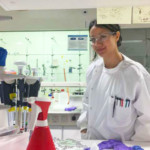![]() Dthief writes: Splitting water is a two-step process, and in a new study, researchers have performed one of these steps (reduction) with 100% efficiency. The results shatter the previous record of 60% for hydrogen production with visible light, and emphasize that future research should focus on the other step (oxidation) in order to realize practical overall water splitting. The main application of splitting water into its components of oxygen and hydrogen is that the hydrogen can then be used to deliver energy to fuel cells for powering vehicles and electronic devices. The process involves exposing the water to a mass of platinum-tipped nanorods, with visible light driving the reaction. The 100% efficiency refers to the photon-to-hydrogen conversion efficiency, and it means that virtually all of the photons that reach the photocatalyst generate an electron, and every two electrons produce one H2 molecule. At 100% yield, the half-reaction produces about 100 H2 molecules per second (or one every 10 milliseconds) on each nanorod, and a typical sample contains about 600 trillion nanorods. Read more of this story at Slashdot.
Dthief writes: Splitting water is a two-step process, and in a new study, researchers have performed one of these steps (reduction) with 100% efficiency. The results shatter the previous record of 60% for hydrogen production with visible light, and emphasize that future research should focus on the other step (oxidation) in order to realize practical overall water splitting. The main application of splitting water into its components of oxygen and hydrogen is that the hydrogen can then be used to deliver energy to fuel cells for powering vehicles and electronic devices. The process involves exposing the water to a mass of platinum-tipped nanorods, with visible light driving the reaction. The 100% efficiency refers to the photon-to-hydrogen conversion efficiency, and it means that virtually all of the photons that reach the photocatalyst generate an electron, and every two electrons produce one H2 molecule. At 100% yield, the half-reaction produces about 100 H2 molecules per second (or one every 10 milliseconds) on each nanorod, and a typical sample contains about 600 trillion nanorods. Read more of this story at Slashdot.
Read the original:
Scientists Achieve Perfect Efficiency For Water-Splitting Half-Reaction







